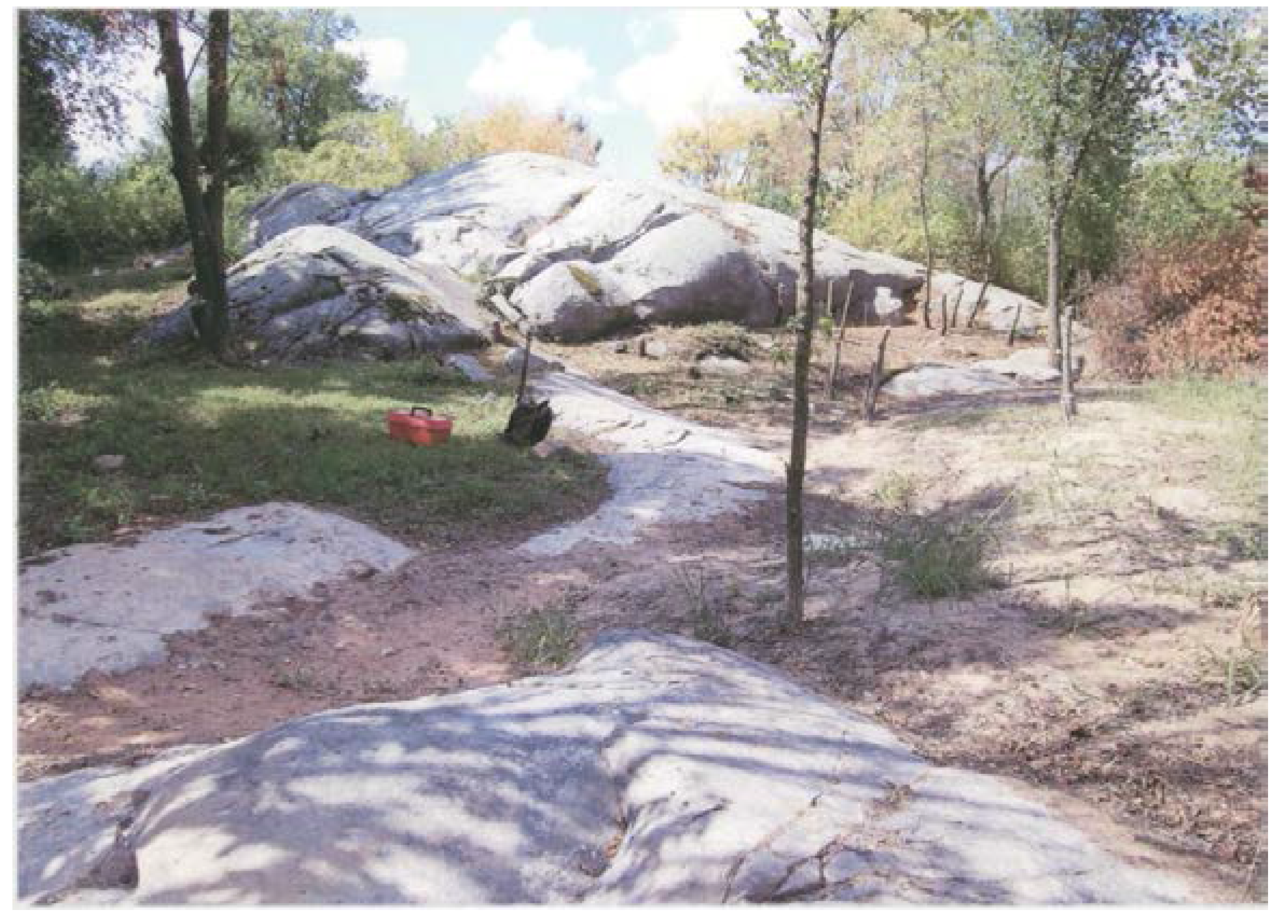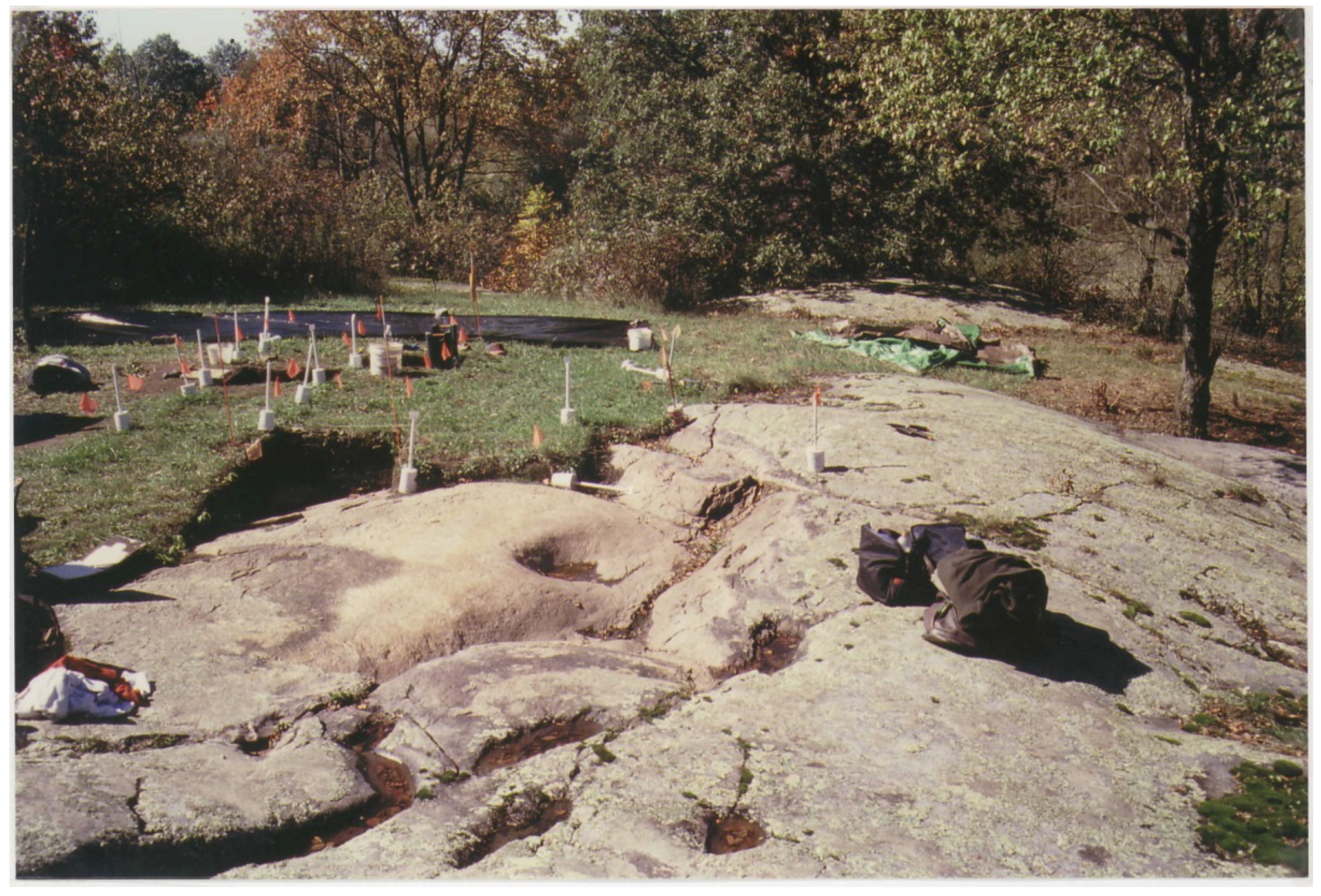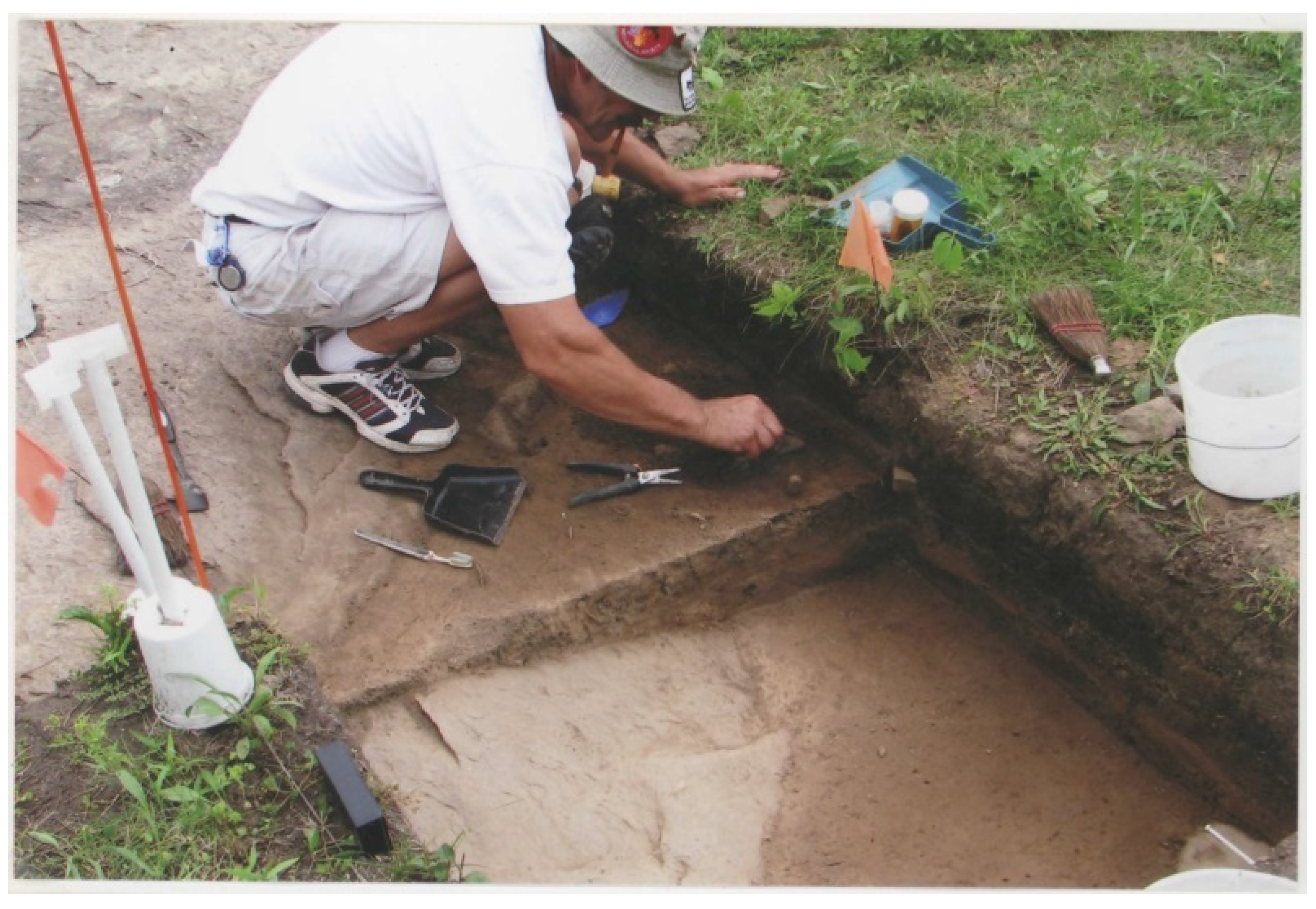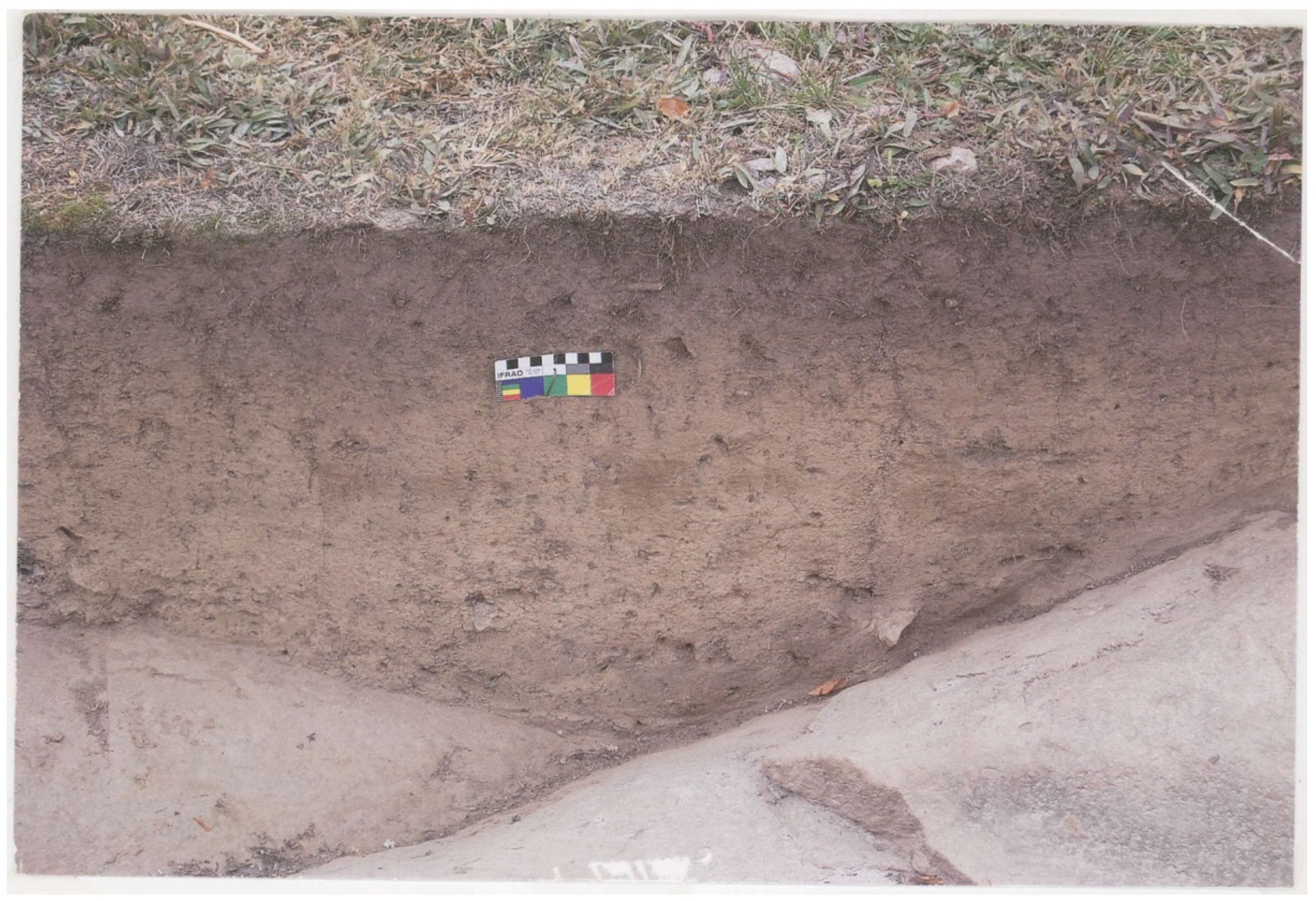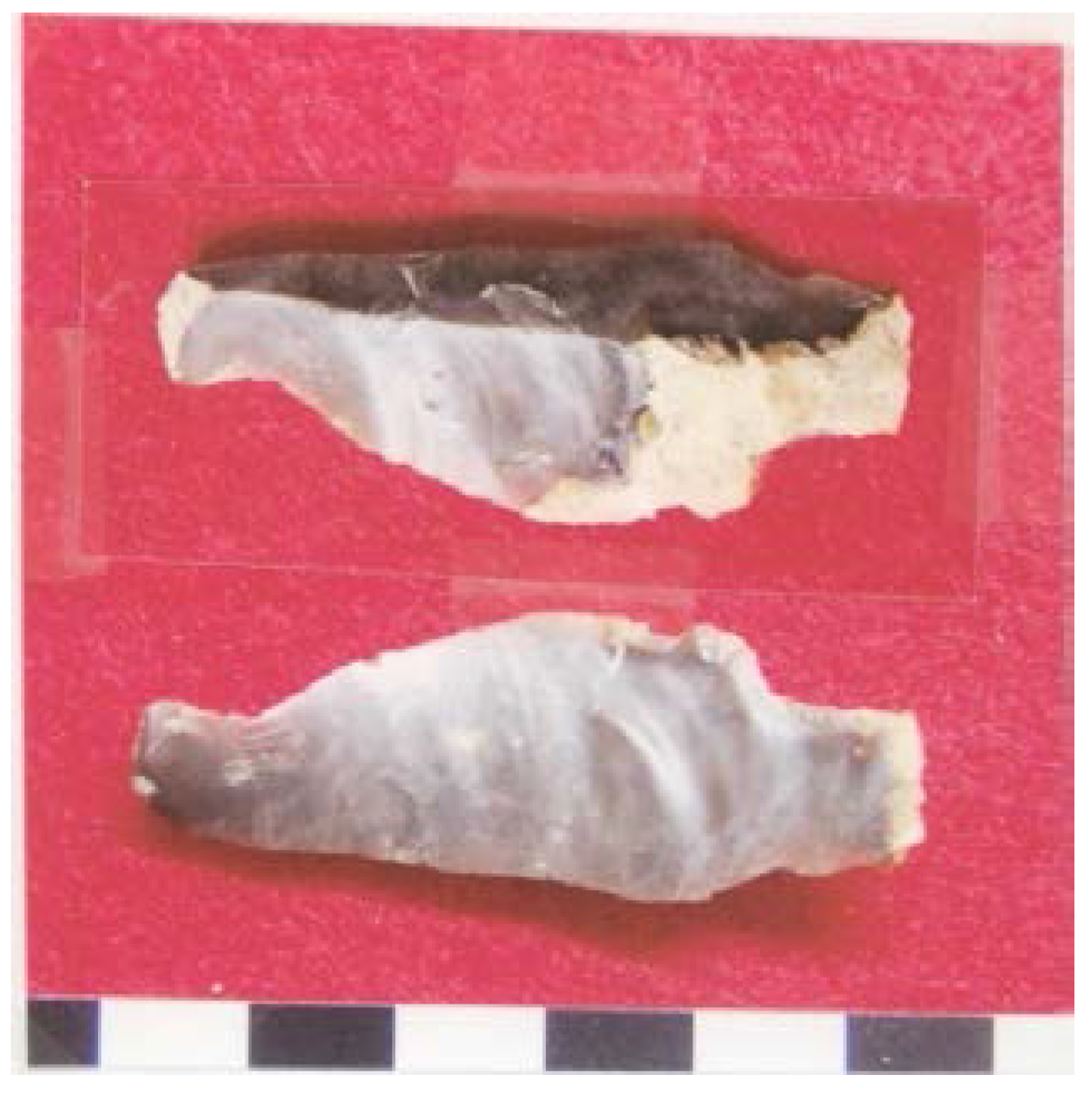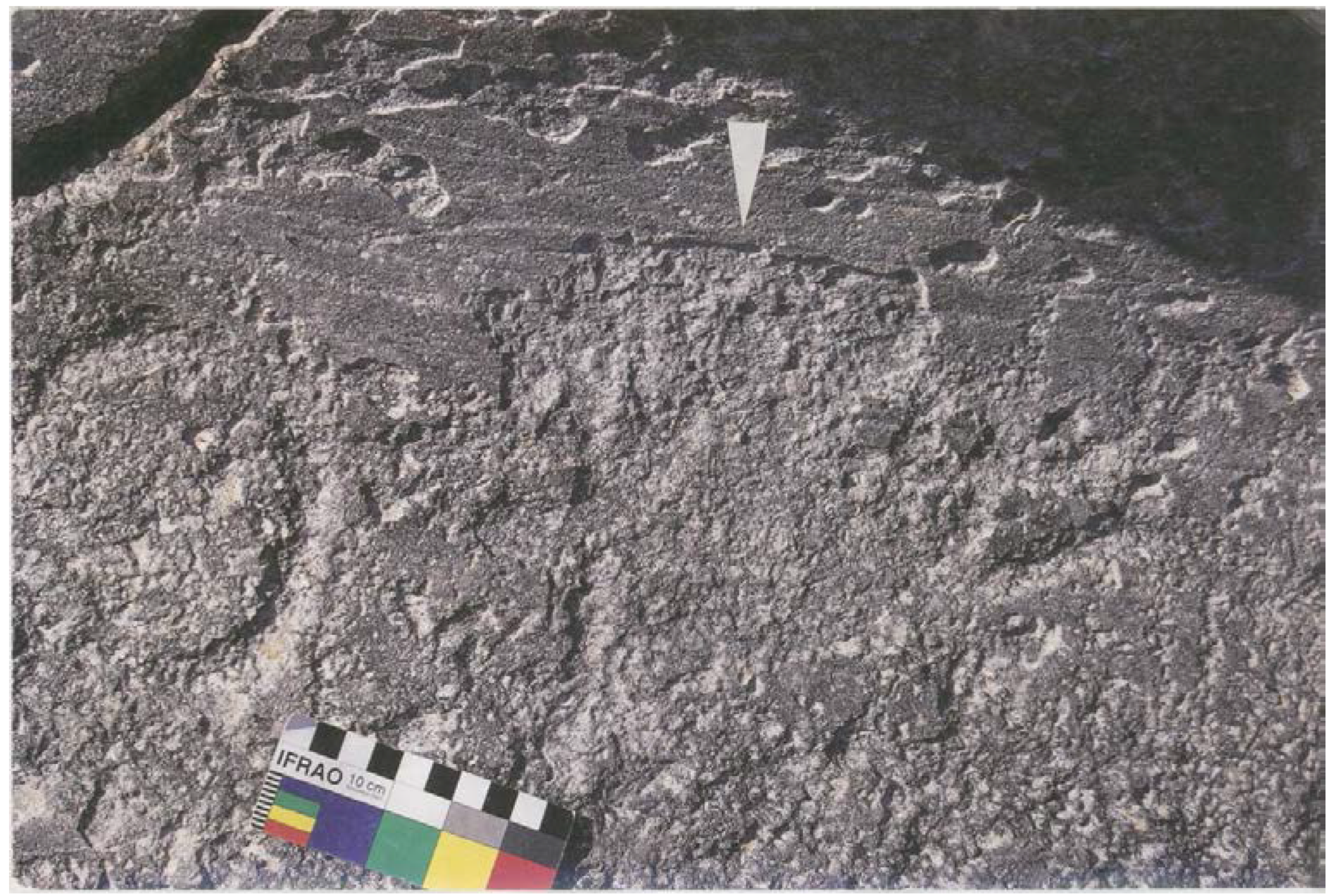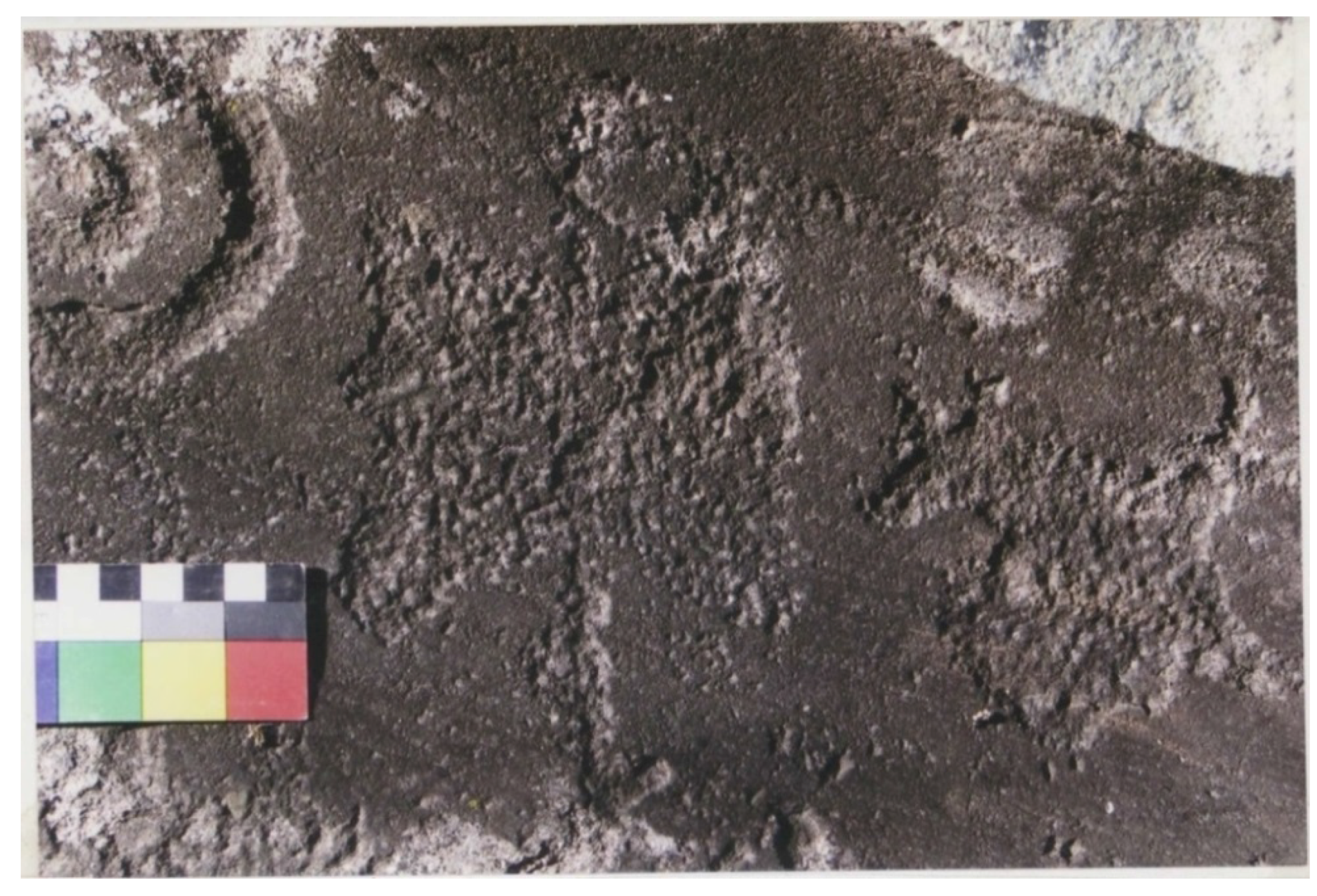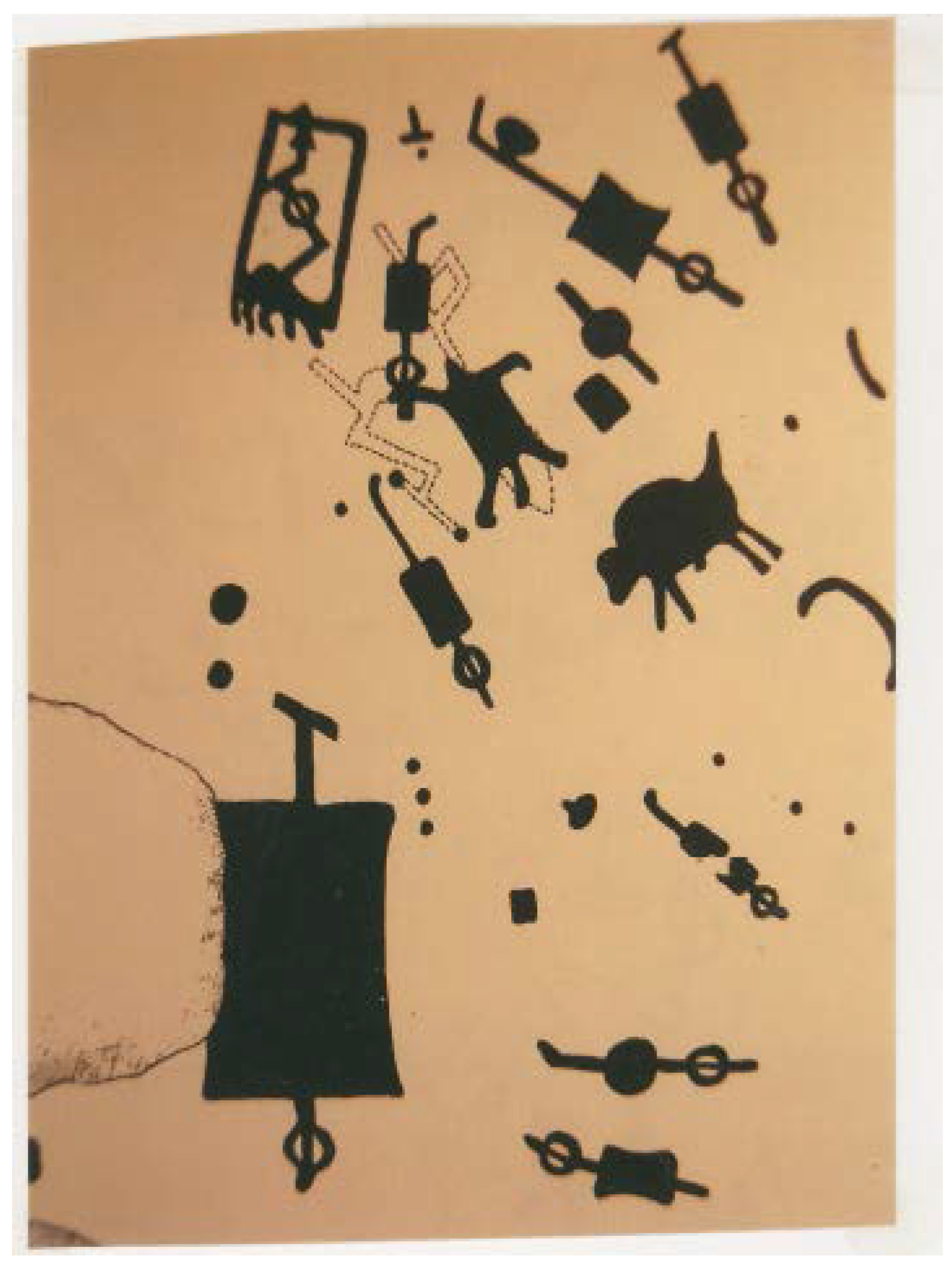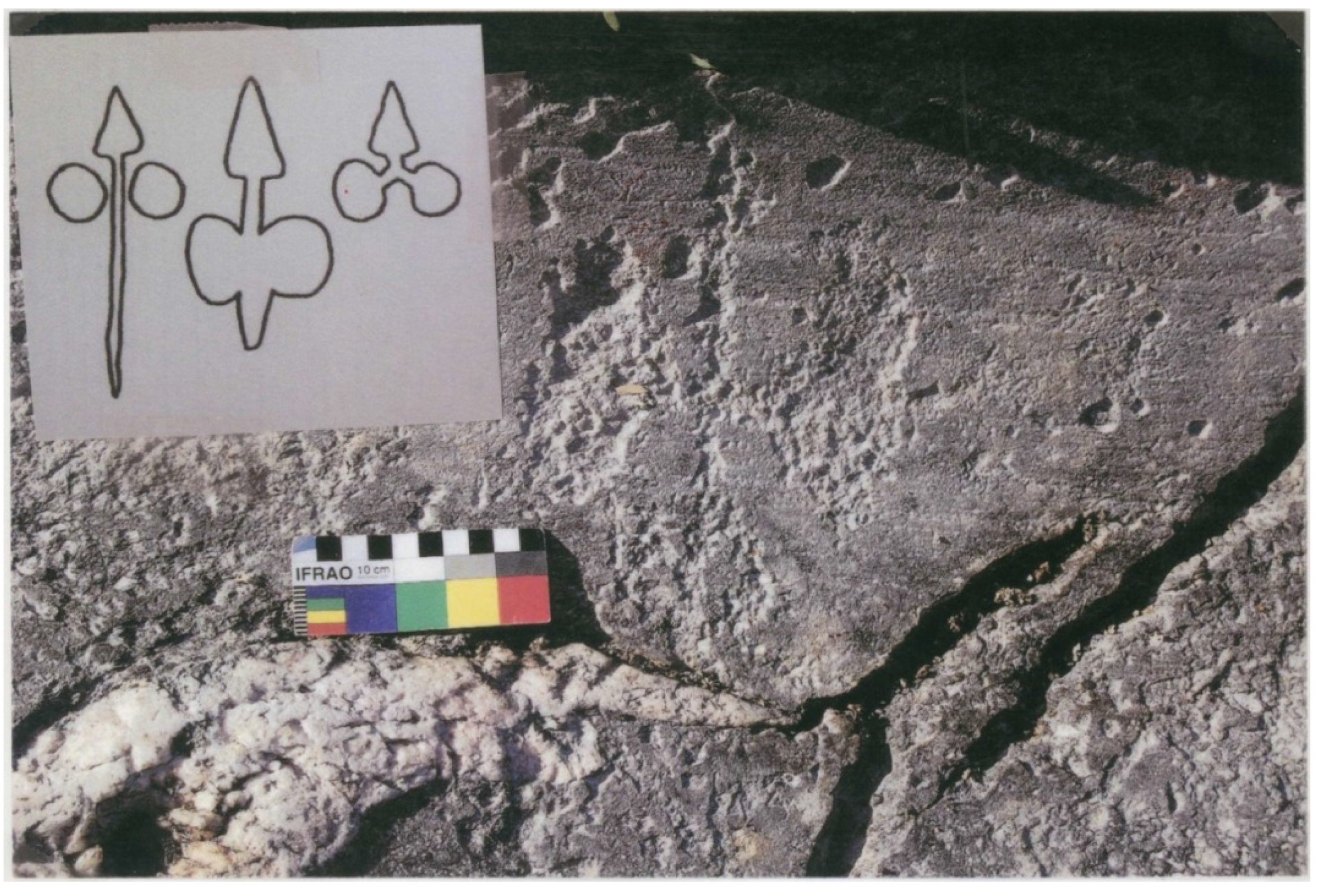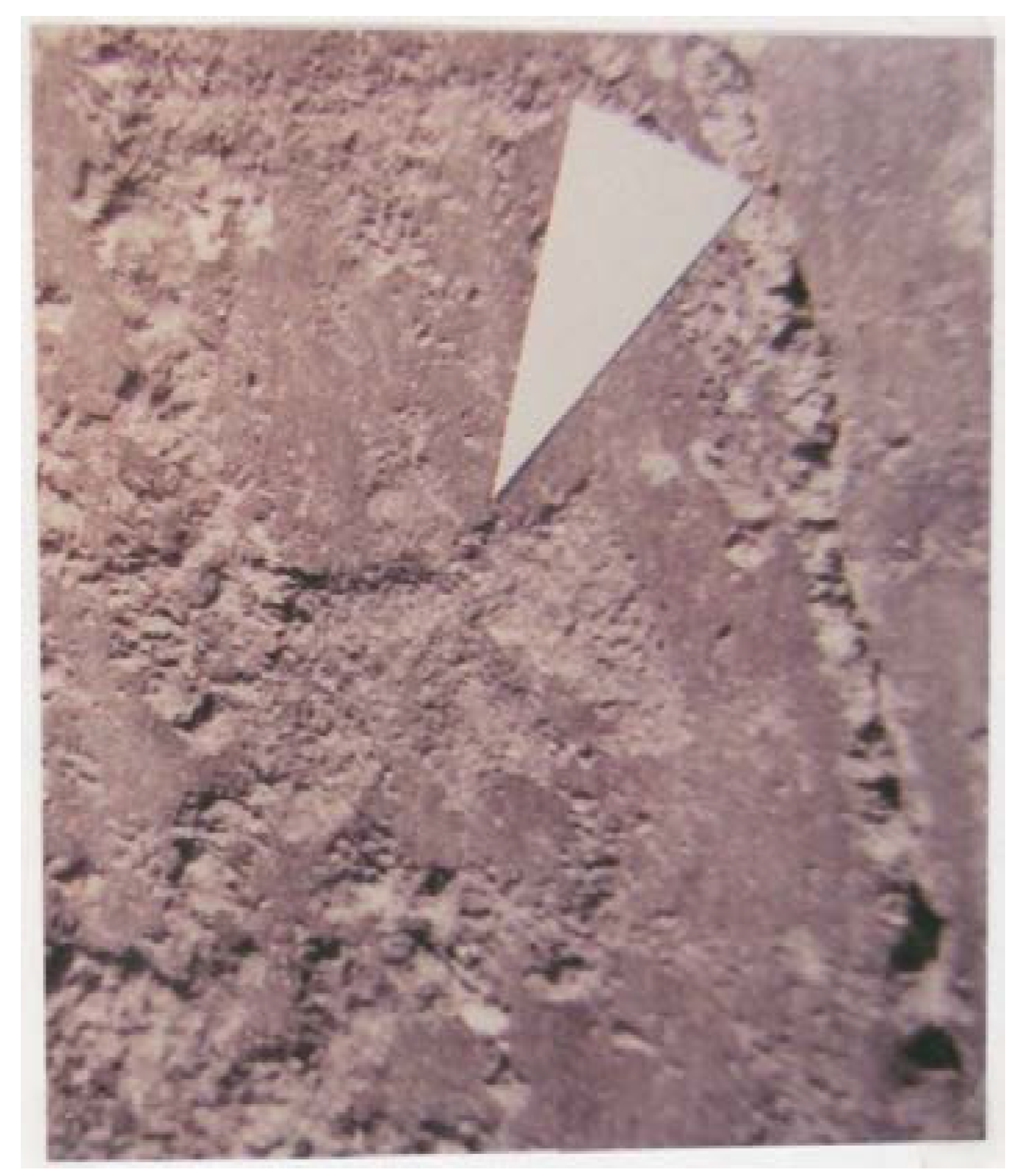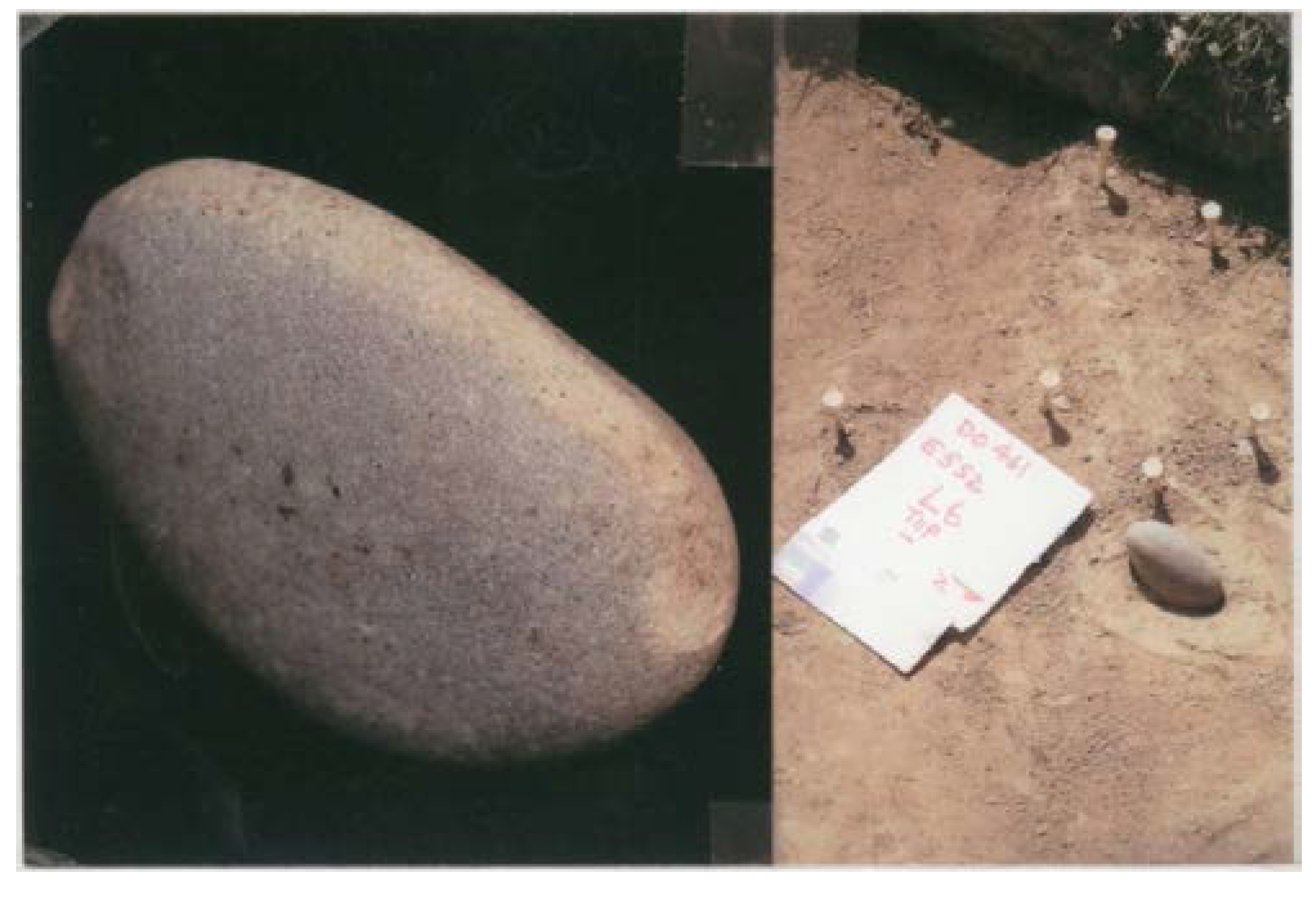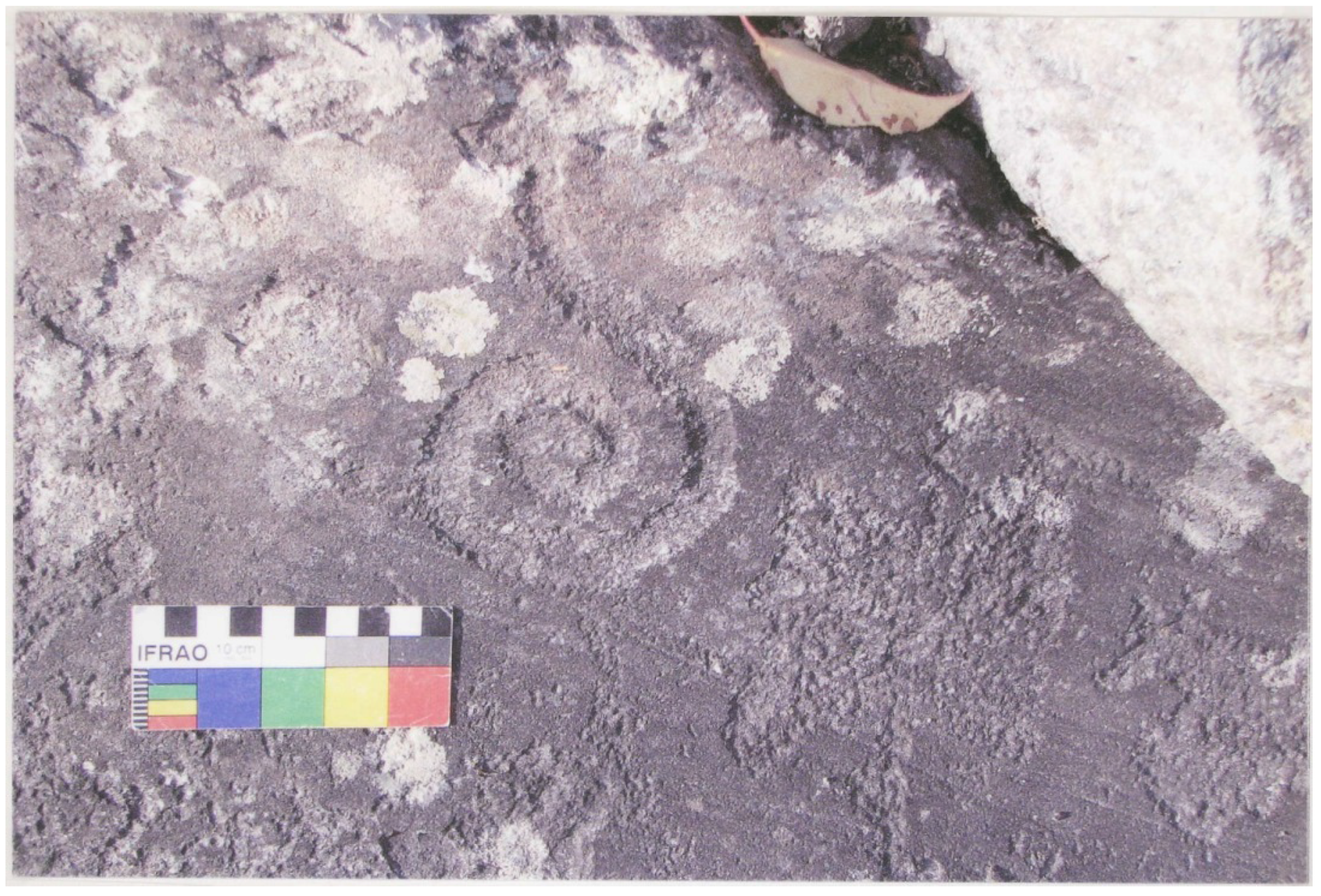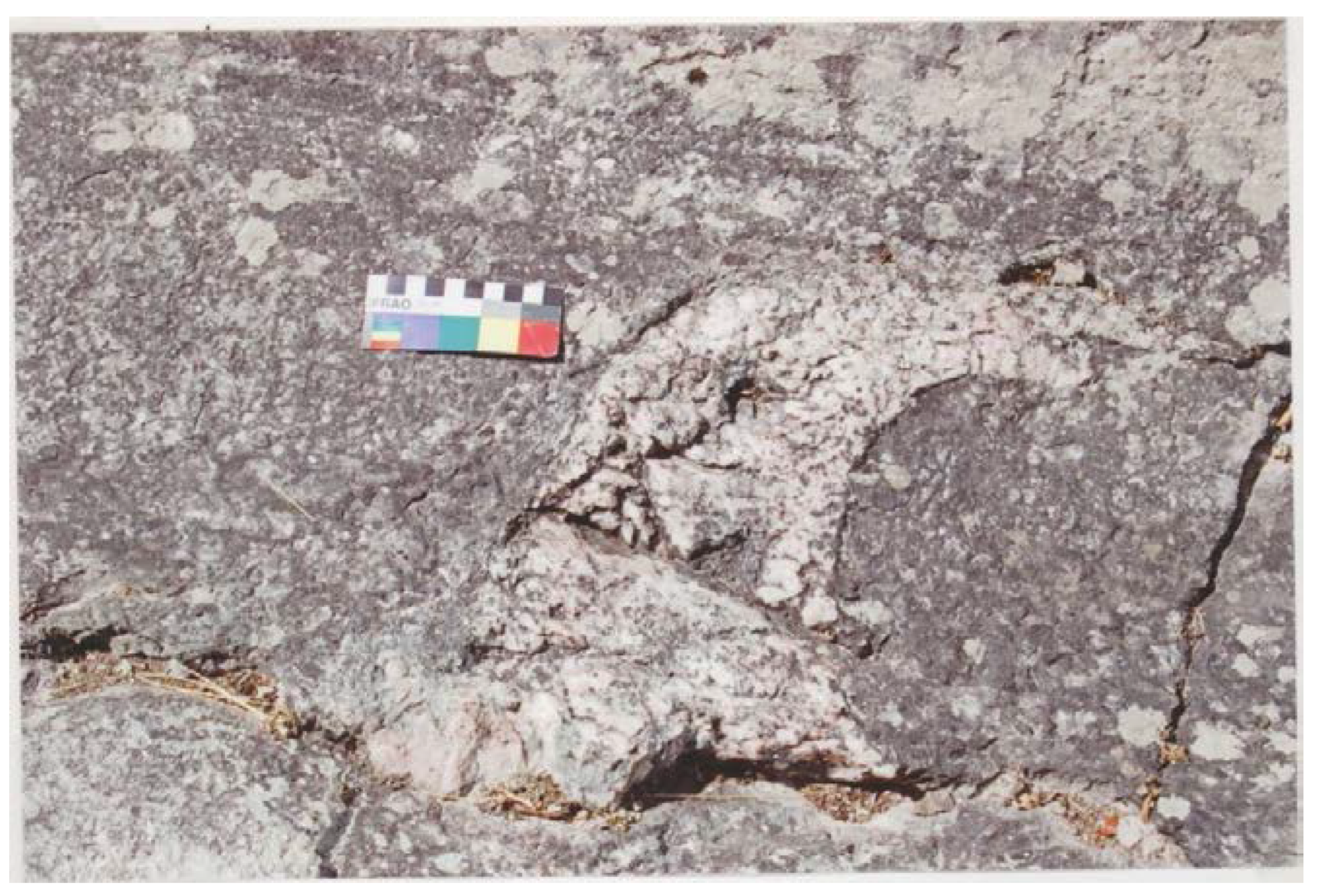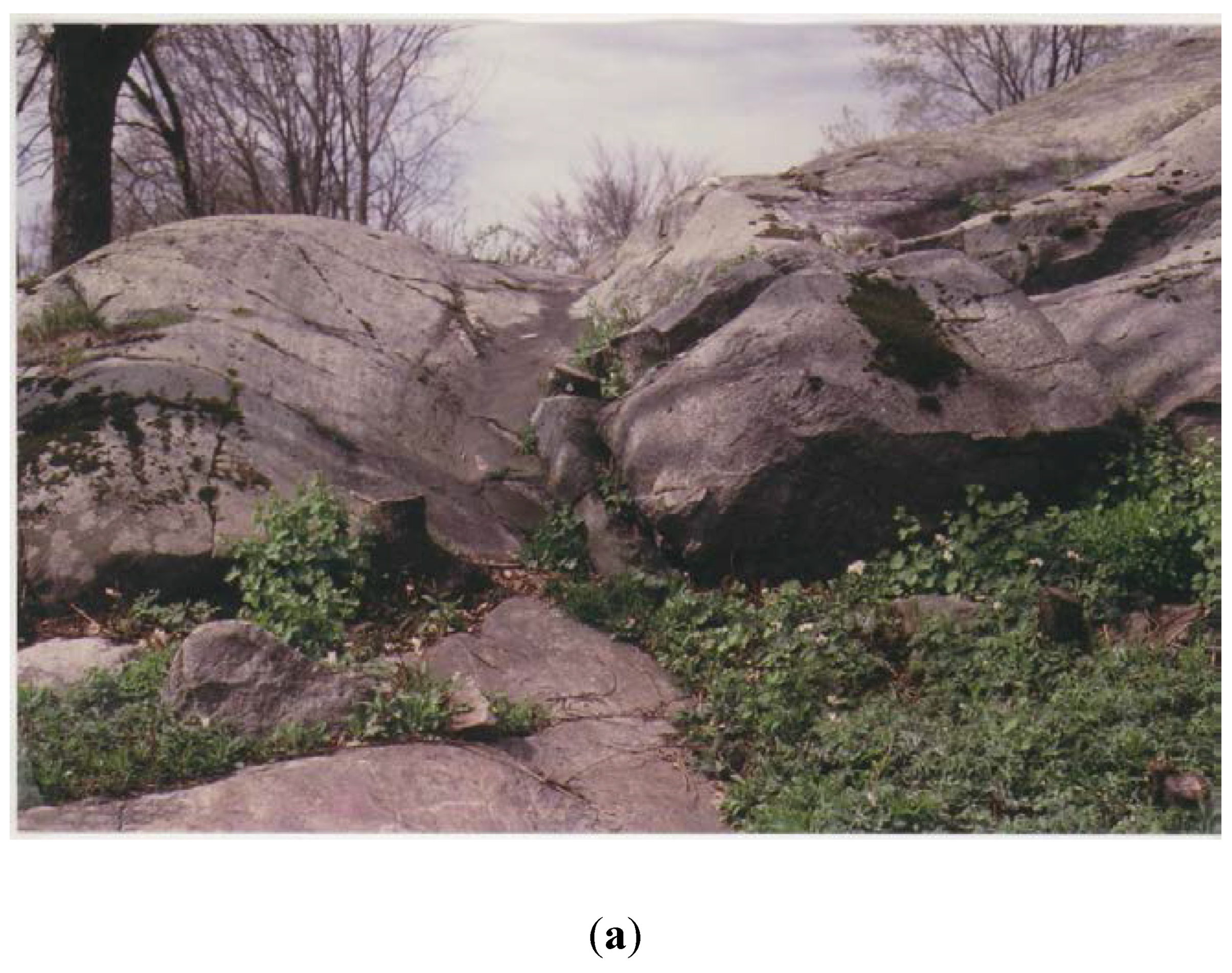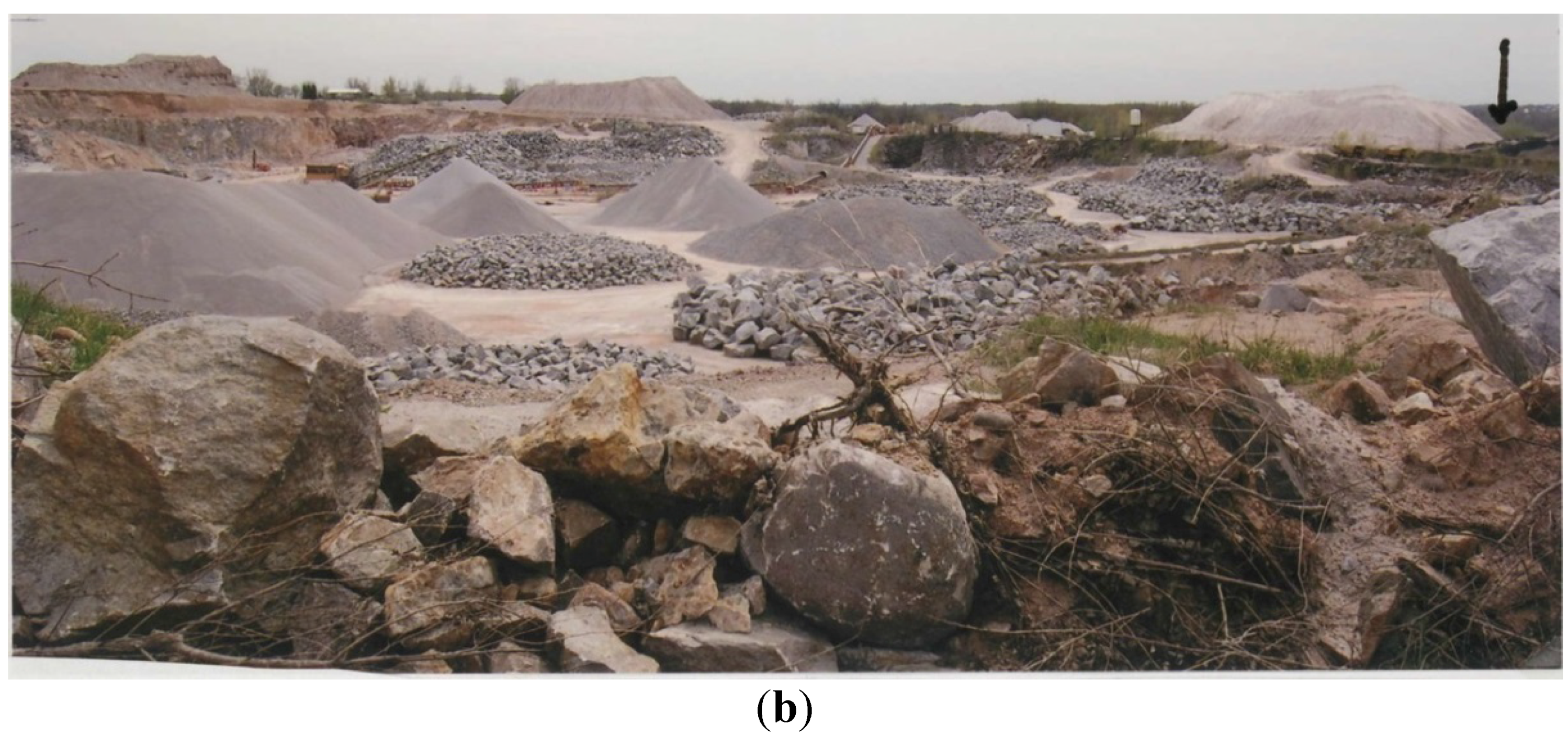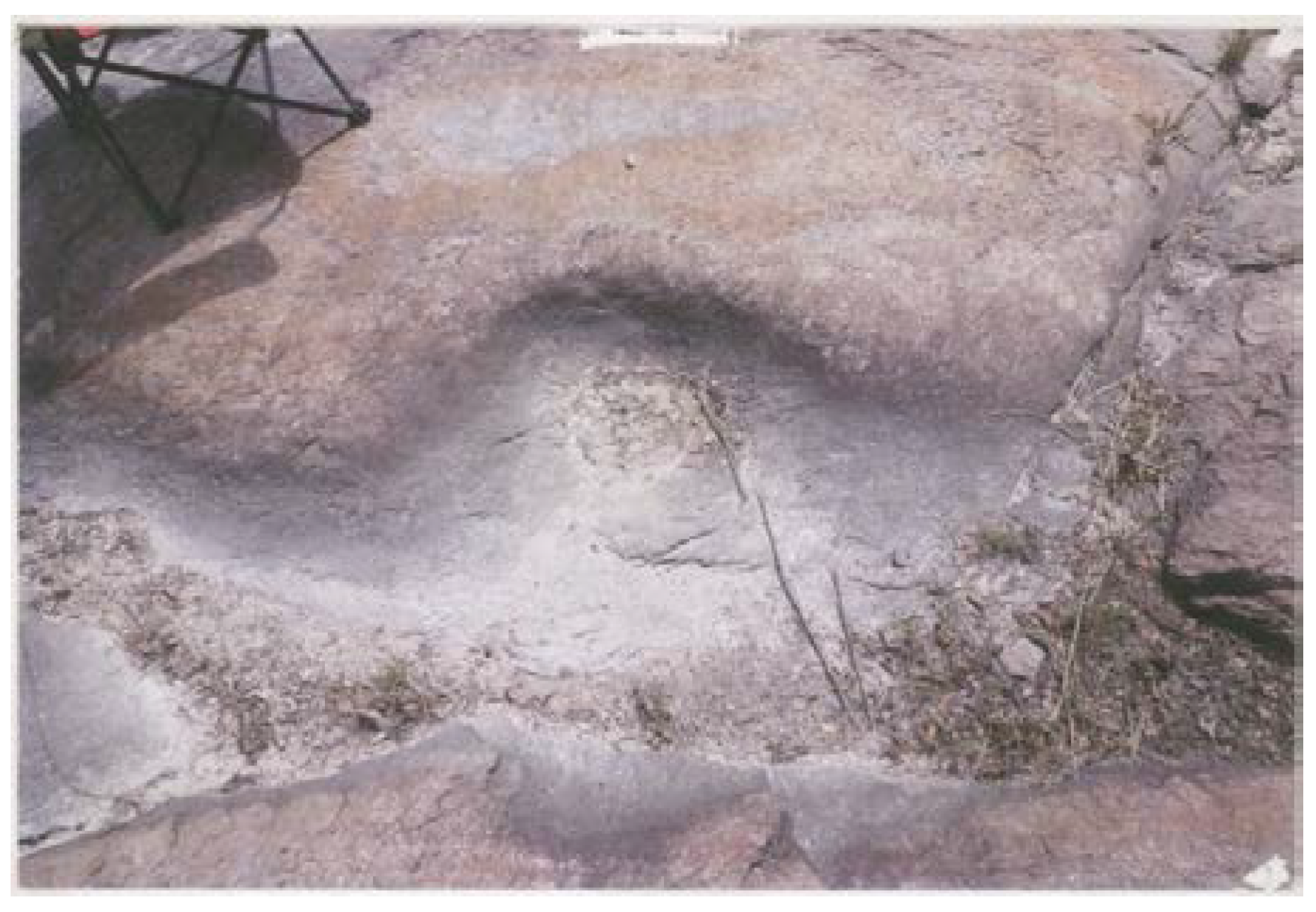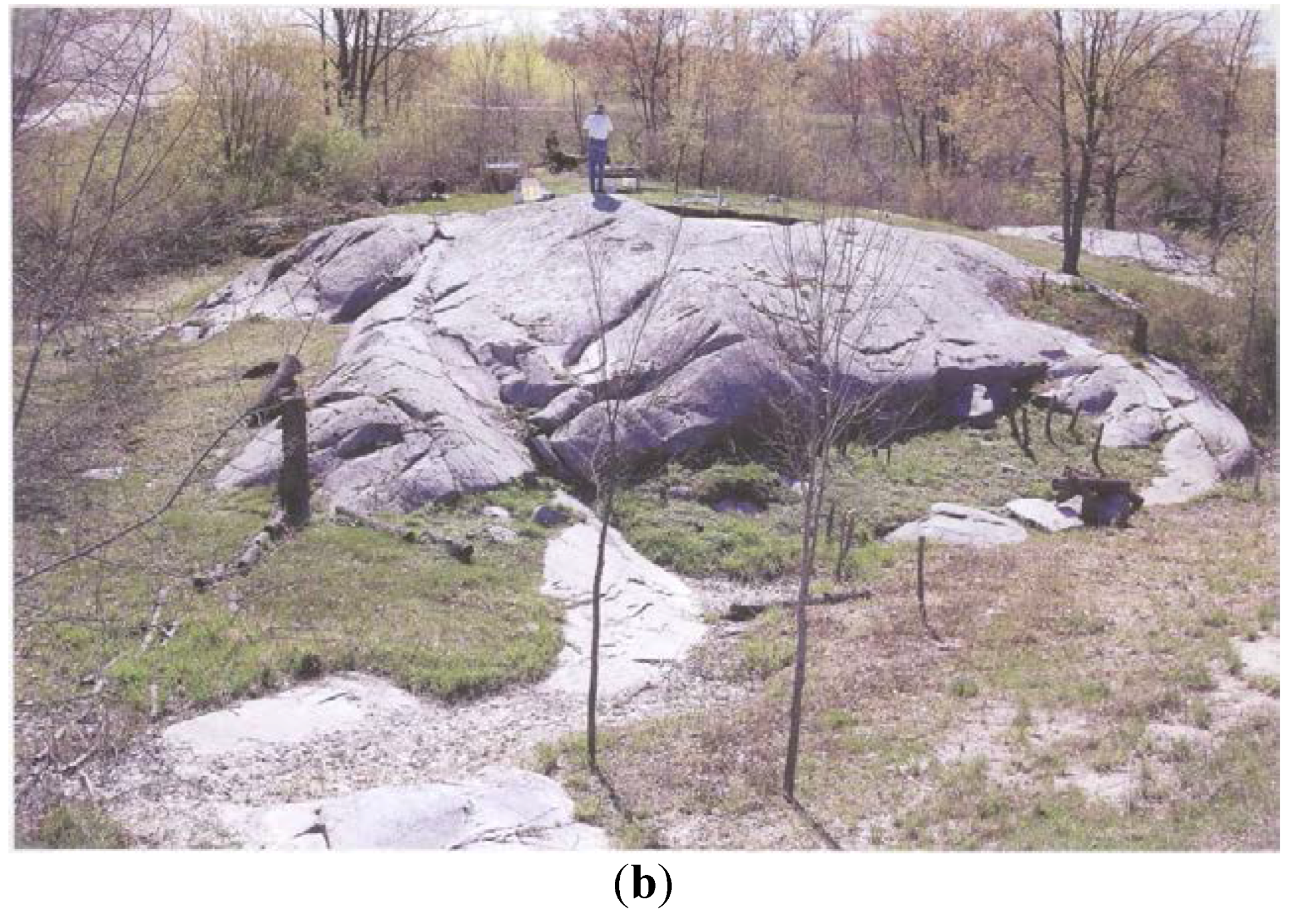The application of standard archaeological methods to rock art sites in America is extremely rare. This is at least partly owing to the apprehension archaeologists have felt toward anything smacking of “art.”
The excavation of the Hensler Petroglyph Site (47-DO-461) in east central Wisconsin (
Figure 1) offers the potential for linking a panel of some 35 engravings (
Figure 2) to a multi-component occupation site immediately adjacent to it (
Figure 3). While it is an absolute fact that proximity alone is no evidence of relationship, the archaeological content may, in some cases, yield hints of relationship and something about the site function, as well as timing. Such findings are, of course, tentative, and their acceptance will depend upon the totality of the interrelated threads of the investigation.
Figure 1.
The Hensler Petroglyph Site (47 DO 461) as viewed from the north. Engravings are on the schist seam to left of center on the dome.
Figure 1.
The Hensler Petroglyph Site (47 DO 461) as viewed from the north. Engravings are on the schist seam to left of center on the dome.
Figure 2.
Decorated seam of Andulusite Schist between domes of Waterloo Quartzite at the Hensler Petroglyph Site. View from North.
Figure 2.
Decorated seam of Andulusite Schist between domes of Waterloo Quartzite at the Hensler Petroglyph Site. View from North.
Figure 3.
Initial excavations at the Hensler Site, 2005. The soil mantle lies 6m from the decorated seam of Andalusite Schist. Photo by author 2005.
Figure 3.
Initial excavations at the Hensler Site, 2005. The soil mantle lies 6m from the decorated seam of Andalusite Schist. Photo by author 2005.
The Hensler Site occupies a regional prominence which overlooks the confluence of the Maunesha and Crawfish Rivers, the Crawfish leading to the Rock River which flows past the large Mississippian village of Aztalan with palisades and pyramidal ceremonial mounds [
1]. The rock art at Hensler includes the eye motif and the bilobate spear, discussed later in the paper, which are patently Mississippian, and radio-carbon dates of A.D. 1200 to A.D. 1250 from the excavations support this timing.
While prominence counts among “phenomenal attributes” [
2] as a site-selection factor, there are several more which undoubtedly played a part in the choice for an engraving site. There is a magnetic anomaly [
3] and the site is subject to innumerable lighting strikes, many of which detach fragments of the intermingled Waterloo Quartzite and Andalusite Schist. Together the quartzite and schist make up the bedrock at the site location. Added to the magnetic anomaly are the extreme winds which race across the prominence. The ground in the vicinity of the engravings contains strong acoustic zones, a feature well known in other North American rock art sites [
4,
5]. Stamping on the surface produces a clear drumming sound. Erosional features in the bedrock have unusual patterns and may also have added to the mystique of the site as site selection factors.
Collectively, these attributes combine to produce an exceptionally unusual place for the conduct of esoteric activities somehow related to the highly diverse engravings.
The surface on which most of the engravings are executed is a linear trough of Andalusite schist which is quite smooth and hard, a suitable surface on which to produce the engravings. It should not be surprising that the imagery covers a time span from perhaps Late Paleo Indian (ca. 11,000 B.P.) to Mississippian culture at ca. A.D. 1250. The archaeology spans an equal range, as does the soils profile.
The well-defined iconographic variations of the main panel clearly reflect different groups over a long time span. This evidence of periodic use is sustained by the variety of lithic styles as well as exotic mineralogical materials throughout the stratigraphy. Since the main panel is the most compelling attribute of the site, it is surmised that this was a major focus of site visits.
The stratigraphy of the occupation area yields two primary zones. The upper one consists of dark organic soil (
Figure 4 and
Figure 5). The radiocarbon dates in this zone range from
ca. A.D. 900 to
ca. A.D. 1250. This zone has yielded the only pottery recovered in the excavations; three undecorated Late Woodland body sherds, not inconsistent with the timing. The most active occupation of the site so far appears to be the Archaic Cultural Tradition of the North American Mid-continent. This tradition is usually dated to between 1000 B.C. and 8000 B.C. It often is characterized by highly artistic polished stone objects, as well as hammered copper tools.
Figure 4.
Initial excavations at the Hensler Site. The upper zones consist of a very dark organic soil which overlies an Aeolian deposit of varying depth because of the surficial topography of the rock formation. Photo by author 2005.
Figure 4.
Initial excavations at the Hensler Site. The upper zones consist of a very dark organic soil which overlies an Aeolian deposit of varying depth because of the surficial topography of the rock formation. Photo by author 2005.
Figure 5.
Excavating down to the Aeolian zone. Except for root snips, metal tools are not used in the Hensler excavations. Excavator is Glen Oechsner. Photo by author.
Figure 5.
Excavating down to the Aeolian zone. Except for root snips, metal tools are not used in the Hensler excavations. Excavator is Glen Oechsner. Photo by author.
The lower zone is especially interesting. It consists of light tan Aeolian sediment, termed löess (
Figure 6). It dates to the period in which katabatic winds scoured the landscape during glacial recession, depositing extremely fine granular material on what was at that time a barren rock surface [
6]. Most of the archaeological recoveries come from this horizon. The typology of the lithics (
Figure 7) proves clearly that the initial occupation of the site occurred at least 10,000 years ago. The act of engraving probably started before that time. This is because projectile points, including Hardin Barbed, the large-Side-Notched Point Tradition, true blades (
Figure 8) (struck from a longitudinally oriented polyhedral core), as well as gravers (a Paleo-Indian diagnostic) occur in the lowest level. And, on the rock surface, below these diagnostics, are the remains of petroglyphs (
Figure 9) already greatly weathered. It would seem that the initial activity at the site was actually engraving itself, and that it occurred before 10,000 years ago. This is entirely consistent with fluted point recoveries at immediately adjacent sites. Fluted points are emblematic of the Paleo-Indian Tradition, the earliest definable culture in North America. Projectile point types, such as Dalton [
7], Thebes [
7], and a possible Hell Gap [
8] point would be dated at only slightly later times in the Hensler excavations and at immediately surrounding sites.
Figure 6.
Exceptionally deep deposit of loess, the oldest soil horizon on the Hensler Site. This zone is highly productive and contains the typologically oldest artifacts. Photo by author.
Figure 6.
Exceptionally deep deposit of loess, the oldest soil horizon on the Hensler Site. This zone is highly productive and contains the typologically oldest artifacts. Photo by author.
Figure 7.
Projectile points relating to the Hensler Site. (
A) A Thebes point recovered from the adjacent Yelk Site, a quarry-workshop site destroyed by modern quarrying. These points are dated between 8000 and 6000 B.C; (
B) A Dalton projectile point, also recovered from the Yelk Site. These points date to between 8500 and 7900 B.C; (
C) Basal part of a large Side-notched Point Tradition specimen excavated from the bottom of the Hensler deposits. These points date from between 8000 and 6000 B.C; (
D) A Hardin Barbed projectile point excavated from the lower strata of the Hensler excavations. These points date to between 8000 and 5500 B.C; (
E). Hi-Lo 8500-8000 B.C. [
7].
Figure 7.
Projectile points relating to the Hensler Site. (
A) A Thebes point recovered from the adjacent Yelk Site, a quarry-workshop site destroyed by modern quarrying. These points are dated between 8000 and 6000 B.C; (
B) A Dalton projectile point, also recovered from the Yelk Site. These points date to between 8500 and 7900 B.C; (
C) Basal part of a large Side-notched Point Tradition specimen excavated from the bottom of the Hensler deposits. These points date from between 8000 and 6000 B.C; (
D) A Hardin Barbed projectile point excavated from the lower strata of the Hensler excavations. These points date to between 8000 and 5500 B.C; (
E). Hi-Lo 8500-8000 B.C. [
7].
Figure 8.
Ventral and dorsal views of a prismatic blade excavated from the Hensler Petroglyph site. The material is Knife River Flint. The blade edge has been completely used. The scale is in centimeters. Photo by author.
Figure 8.
Ventral and dorsal views of a prismatic blade excavated from the Hensler Petroglyph site. The material is Knife River Flint. The blade edge has been completely used. The scale is in centimeters. Photo by author.
Figure 9.
The remains of marking beneath all strata in the Hensler excavations. There are four areas of acutely weathered peck marks. Arrow points to an extremely weathered image, to some resembling a butterfly. Photo by author.
Figure 9.
The remains of marking beneath all strata in the Hensler excavations. There are four areas of acutely weathered peck marks. Arrow points to an extremely weathered image, to some resembling a butterfly. Photo by author.
In a recent re-evaluation of the glaciology of the region, it has been established that complete deglaciation occurred 15,000 years ago [
9]. In as much as engraving appears to be the initial site activity, the potential for “pre-Clovis” rock art is raised.
The engravings may supply a prospective link to Paleo-Indian Culture in that a lanceolate, concave based projectile point image (
Figure 10) is present on the main panel. Moreover, this specimen is twinned. Two similar images are superposed in roughly opposite directions. The size of the image is very near that of the in-hand forms, and is most similar to a Clovis variant at the Debert Site in Nova Scotia [
10]. Debert is dated at
ca. 9000 B.C., and is likely a late timing for the type.
Figure 10.
Superimposed images of a lanceolate, concave-based projectile point on the main panel at the Hensler Petroglyph Site. This unprecedented image is about the same size (8.0 cm) as are in hand specimens. Photos by author.
Figure 10.
Superimposed images of a lanceolate, concave-based projectile point on the main panel at the Hensler Petroglyph Site. This unprecedented image is about the same size (8.0 cm) as are in hand specimens. Photos by author.
Linkage to the engraved panel may be made in general by the finding of what we call “expedient imagery” (
Figure 11). As the name implies this is imagery which occurs in nature. An object, usually of stone, is collected for use in some kind of ritual act. It may have a shape akin to one that might be needed. Collection and use of objects like this is not uncommon among aboriginal populations of North America. In the case at Hensler, the first of these to be encountered in the excavations is a form resembling a bird or possibly a reptile (
Figure 11c). The piece was recovered at level 8 and was flat on the surface. In fact, this specimen is cloven (the other piece missing) so that it might remain stable on the ground. The underside of this piece is rough from the detachment, not smooth like the top. Its orientation was consistent with Mid-winter sunset. The object is a glacially transported and abraded piece, having only slight embellishment at the “eye.” It may well have remained in the location of its discovery since it functioned there on the living floor.
Figure 11.
Examples of “expedient imagery”. (A) a small pebble resembling a bison; (B) an erratic resembling a frog and covered with red pigment; (C) an erratic resembling a bird or reptile. This specimen had been longitudinally cloven, possibly to enhance stability upon placement; (D) a possible phallic representation; (E) possible Zoomorph. Photos by author.
Figure 11.
Examples of “expedient imagery”. (A) a small pebble resembling a bison; (B) an erratic resembling a frog and covered with red pigment; (C) an erratic resembling a bird or reptile. This specimen had been longitudinally cloven, possibly to enhance stability upon placement; (D) a possible phallic representation; (E) possible Zoomorph. Photos by author.
Another example of expedient imagery is what appears at one angle to be a frog (
Figure 11b). Again, this object is a small glacial erratic, well smoothed and with a thickly applied coating of red ochre. Frogs are spiritually malevolent in Algonkian mythology, and this object might be seen as serving as a kind of hex.
Much like the common contents of “medicine bags” a little bison may have been picked from glacial gravels for its appropriate form (
Figure 11a). At least two bison images are present along the main panel (
Figure 12), thus suggesting that bison may have figured in the lifeways of some of the site inhabitants.
Figure 12.
Arrow points to a naturalistic, solidly pecked bison image on the main panel of the Hensler Petroglyph Site. Photo by author.
Figure 12.
Arrow points to a naturalistic, solidly pecked bison image on the main panel of the Hensler Petroglyph Site. Photo by author.
That hunting (
Figure 13) was important is indicated in a remarkably well made atl-atl image on the main panel. This specimen has both the handle and the propelling tip. The weight (sometimes call “Banner Stones”) is much like one commonly referred to as the “butterfly type.” The nearest clear comparison for this form is at the Jeffers Petroglyph Site in southwest Minnesota [
11] (
Figure 14). The atl-atl is again a diagnostic for the Archaic Tradition which it represents at both Jeffers and Hensler.
Figure 13.
A “butterfly” type atl-atl on the main panel at the Hensler Site. Atl-atls in general are diagnostic for the Archaic Tradition in North America Pre-history. Photo by author.
Figure 13.
A “butterfly” type atl-atl on the main panel at the Hensler Site. Atl-atls in general are diagnostic for the Archaic Tradition in North America Pre-history. Photo by author.
Figure 14.
Atl-atls at the Jeffers Petroglyph Site in southwestern Minnesota. A date of c.a. 5000 BP has been assigned to them at the Jeffers Site. They could be much older. [
12]
Figure 14.
Atl-atls at the Jeffers Petroglyph Site in southwestern Minnesota. A date of c.a. 5000 BP has been assigned to them at the Jeffers Site. They could be much older. [
12]
The connection with The Jeffers Site is strengthened by a lithic resource expressed in prismatic blades near the bottom of the strata (
Figure 8). This is Knife River Flint which originates in North Dakota. The material was first identified in a Wisconsin site by James Warren Porter in 1962. Porter viewed the material microscopically, and discovered the cell structure of petrified wood [
13]! This material is highly suited to finely made flint tools, and shows a connection between The Hensler Site and areas far to the northwest.
Other exotic stone at Hensler includes Hixton Silicified Sandstone (also called Hixtonite) which outcrops at Silver Mound, an extensive aboriginal quarry some 200 miles northwest of the site. Along with the iconographic ties to Jeffers, these lithic resources combine to suggest a northwesterly cultural connection at an early point in the Hensler occupations.
By the same token, a combination of lithic resources and iconography point to southern cultural connections. The images shared with southern sites include the “bi-lobate” spear (
Figure 15), the eye motif, compartmental rectangles, and meandering lines (or the “serpent motif”). These elements do not occur to the north on rock art sites, and are abundant in the south, especially in Missouri where they are deemed symbols of the “Southern Cult,” a Mississippian phenomenon dating to around A.D. 1200 [
14]. Along with the presence of Galena Chert and other southerly lithic resources, a firm assertion of southerly site connections is appropriate.
Figure 15.
A “bilobate spear” of Mississippian culture, ca. A.D. 1100–1250. This shows clear southern influences. Photo by author.
Figure 15.
A “bilobate spear” of Mississippian culture, ca. A.D. 1100–1250. This shows clear southern influences. Photo by author.
The iconography also suggests westerly connections, especially with the thunderbird motif [
15] (
Figure 16). There are no apparent connections to the east. However, the diversity of imagery suggests the presence of several external cultural sources over a very long span of time. This view is sustained by the diversity of classifiable artifacts in the excavations. The overall result of these findings is that diverse groups over thousands of years visited briefly at this site, probably with some attention to the engravings. This suggests a persisting cultural awareness of the engravings over a wide geographic area. The periodic presence may point to the “pilgrimage effect.” Small groups travel to the site in order to follow some ritual procedures pertaining to the rock art, perhaps adding to first, the flat inviting surface of the crown, and secondly, to the main panel itself.
Figure 16.
A solidly pecked thunderbird on the main panel at the Hensler Petroglyph Site. The style may suggest a westerly influence [
15]. Photo by author.
Figure 16.
A solidly pecked thunderbird on the main panel at the Hensler Petroglyph Site. The style may suggest a westerly influence [
15]. Photo by author.
The excavations reveal that the principal activity at the site is lithic artifact repair, and
not basic manufacture (
Figure 17). The vast majority of the thousands of artifact recoveries are small retouch flakes. Cores are absent. Charcoal is found throughout most levels, and there is one hearth containing red ochre, a lithic blank, and small flakes. We interpret this to mean that the hearth was used to repair bifaces and to complete the manufacture of a biface. Heat is employed to anneal the stone, making it easier to process.
Figure 17.
A small pecking hammer recovered at the top of level 6 at the Hensler Petroglyph Site. The tees surrounding it show the in-situ retouch flakes directly associated with the hammerstone. Photo by author.
Figure 17.
A small pecking hammer recovered at the top of level 6 at the Hensler Petroglyph Site. The tees surrounding it show the in-situ retouch flakes directly associated with the hammerstone. Photo by author.
The technology employed in the execution of the petroglyphs is uniformly solid pecking. The contiguous pecking of the images, as opposed to outline, exhibits mass and is thus realistic. Outlining is an abstraction. Animals, the atl-atl, projectile points, anthropomorphs, and the thunderbird are all solid images, contiguously pecked to convey mass. Even elements like the eye, circles, and a beautifully executed spiral (
Figure 18) are solidly pecked. While there is a very wide timeline among all of these forms, the basic technology remains the same. The Andalusite schist upon which the petroglyphs are made is sufficiently soft for grooving or incising, but neither is used. All images are contiguously pecked. It would seem that a rule about technique prevails through both time and culture. The technique becomes part of the taxonomy, the rigidity of which might well imply penalties (at least supernaturally) for violations. Precedence for this among aboriginal societies is virtually infinite.
Figure 18.
A very clearly executed “anti-clockwise” spiral on the main panel at Hensler. This spiral was reproduced with dental acrylic after a process first used by L.R. McBride (1976) in Hawaii [
3].
Figure 18.
A very clearly executed “anti-clockwise” spiral on the main panel at Hensler. This spiral was reproduced with dental acrylic after a process first used by L.R. McBride (1976) in Hawaii [
3].
The imagery along the main panel is not all man-made. Following the model presented by expedient imagery, a birdlike image (
Figure 19) in the form of a natural quartz vein near the center of the panel must surely have entered into the rock art experience. It may even have been a site selection factor! And, from this, we may project an even more contentious idea. The panel itself as viewed from the north (
Figure 20a) may act as a sexual symbol; again a potential site selection factor not unprecedented among North American rock art sites [
16].
Figure 19.
An “eagle head” comprised of a quartz vein in the main panel at the Hensler Petroglyph Site. With engravings all around it, this natural feature may follow the idea of “expedient imagery”, and may, in fact, have been a site selection factor. Photo by author.
Figure 19.
An “eagle head” comprised of a quartz vein in the main panel at the Hensler Petroglyph Site. With engravings all around it, this natural feature may follow the idea of “expedient imagery”, and may, in fact, have been a site selection factor. Photo by author.
Figure 20.
(a) View of main panel from the north. Like many other rock art sites, especially in California, the whole site may have offered a female sexual symbol, like, perhaps, a “Mother Goddess”. This may have been a fundamental site selection factor. (b) The quarry which virtually surrounds and adjoins the Hensler Petroglyph Site. Arrow points to the site location. The quarry operations include extensive crushing which results in enormous piles of very fine dust. This dust is subject to extensive redistribution by winds, frequently falling over the site. Photos by author.
Figure 20.
(a) View of main panel from the north. Like many other rock art sites, especially in California, the whole site may have offered a female sexual symbol, like, perhaps, a “Mother Goddess”. This may have been a fundamental site selection factor. (b) The quarry which virtually surrounds and adjoins the Hensler Petroglyph Site. Arrow points to the site location. The quarry operations include extensive crushing which results in enormous piles of very fine dust. This dust is subject to extensive redistribution by winds, frequently falling over the site. Photos by author.
Since the initial report on the Hensler Site in 1987 [
3], more petroglyphs have been discovered. This is because illumination of the engravings is dependent upon exacting light angles. For most of the day the petroglyphs are not visible. Only at times of acute grazing light in the early morning and late afternoon, on cloudless days, are the markings best seen. Even with this, at many times of the year all of the engravings may not be visible. Since 2005 at least three very clear petroglyphs have been added to the inventory. Each day throughout the year is different, and the newly added glyphs have become illuminated at particular light angles not present at any other time. This raises the question whether knowledge of light angles might be part of shamanistic manipulations [
17]. Among the Northern Ojibwa, an informant reported that a shaman’s client was ordered to view a rock face at a certain time to see an image “magically” appear. While the case in point involved a rock painting, engravings would be even more susceptible to such a use.
Collectively, the many features of this site may be seen to add up to a powerful and persuasive total. The site is special. The physical properties of it have attracted the representatives of many and diverse cultural groups over a profoundly long time span. It would certainly seem that the knowledge and use of this site, including the “pilgrimage effect” would surpass both linguistic and cultural boundaries.
From all this, it is unfortunate that such an important site is seriously threatened. In 1986, when the site first was seen by rock art specialists, it was entirely enclosed by a working farm. Within two years and after the initial report on the site was published, the farm was purchased by quarry interests (
Figure 20b). At least one adjoining aboriginal quarry-workshop site was totally destroyed. The expansion of the quarry has now led to many enormous piles of “quarry dust” (
Figure 21) which falls upon the engravings and over all of the site surroundings. Our investigation of the physical and chemical components of this dust from the crushing operation reveals that the material contains some abrasive components. And, as it builds up, filling slight depressions on the main panel, it enhances the growth of lichen which in turn threatens the integrity of the glyphs. No professional investigation of the conservation and preservation issues of the site has ever been done.
Figure 21.
Quarry dust accumulating on the Hensler Petroglyph Site 2012. Photo by author.
Figure 21.
Quarry dust accumulating on the Hensler Petroglyph Site 2012. Photo by author.
Large exposures of smooth surfaced quartzite and schist outcrops were destroyed before they were examined for markings. A large adjacent area to the north which has yielded many hundreds of artifacts, including fluted points (normally dating to at least 9,000 B.C.), has recently been purchased by the quarry. It seems inevitable that a critically relevant site will eventually be destroyed.
The purchase of the Hensler farm led immediately to the radical alteration of available research time at the site. Sundays have been the only day available since there is often quarry work going on six days of the week. So, work is normally limited to Sundays with fair weather. At this time, only 1.2 percent of the site has been excavated. The site is clearly shown to be the oldest rock art site in Wisconsin, and its more comprehensive investigation would certainly lead to additional significant findings.
It is also unfortunate that the construction of a huge berm (
Figure 22) around the entire rock art site has completely destroyed the site ambience originally so vital in site selection. Moreover, the prospect of astronomical properties of the site cannot now be fully researched.
Figure 22.
(a) North arm of the berm as seen from the south edge of the site. (b) View of site from north arm of the berm. Excavations are immediately past rock formation. Photos by author.
Figure 22.
(a) North arm of the berm as seen from the south edge of the site. (b) View of site from north arm of the berm. Excavations are immediately past rock formation. Photos by author.
